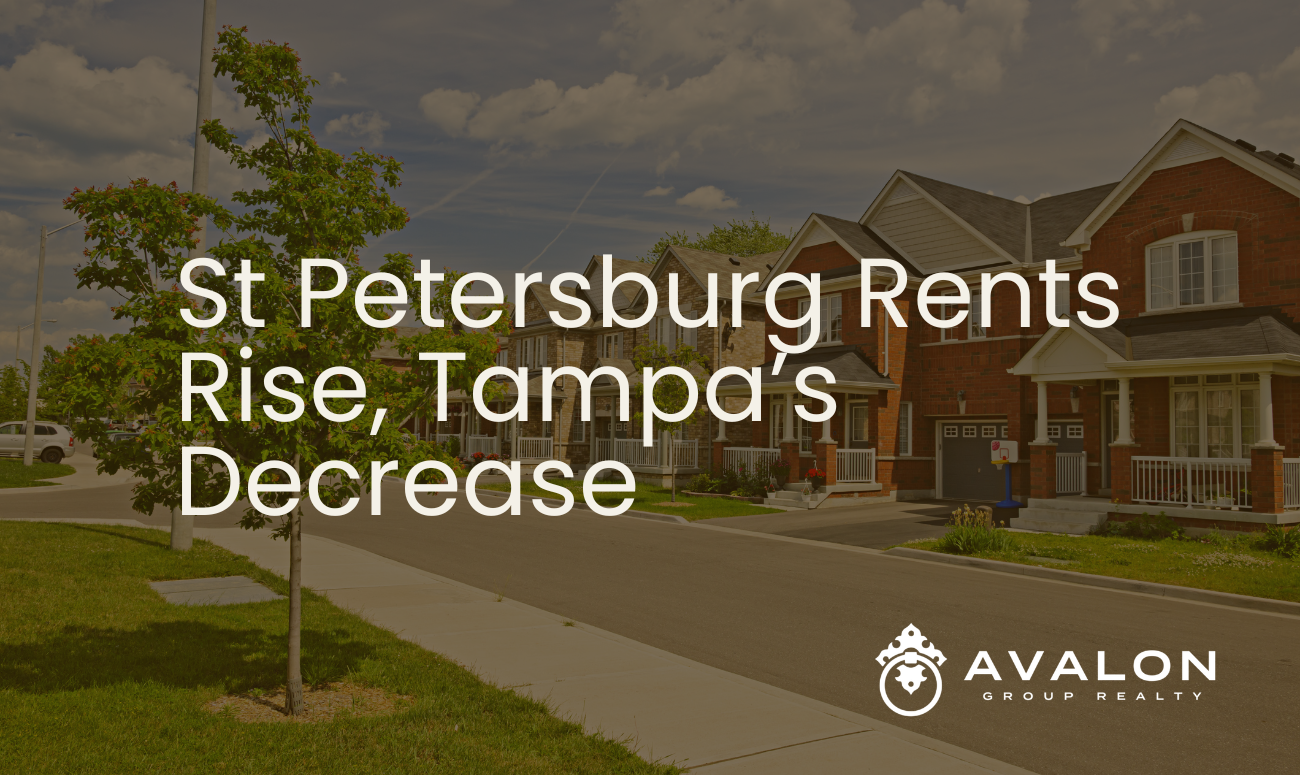St Petersburg Rents Rise: Tampa rents decrease, while St. Petersburg rents rise, new report shows February 2024
Introduction
A new report released this month by RentHop shows that rents in Tampa decreased over the past year, while rents in nearby St. Petersburg increased significantly. Specifically, the report found that median rents for 1-bedroom apartments in Tampa dropped by 1.3% from January 2023 to January 2024. However, median rents for 1-bedroom units in St. Petersburg rose by 9.4% during the same period.
This article will analyze the key findings from the RentHop report and discuss why rents are moving in opposite directions in these two Florida cities. We’ll also look at some of the factors that may be contributing to these rent trends.
St Petersburg Rents Rise: Breakdown of Rent Changes in Tampa
RentHop’s data shows that the median rent for a 1-bedroom apartment in Tampa fell from $1,995 in January 2023 to $1,970 in January 2024. Although this is a relatively small decrease percentage-wise, it still marks a reversal from years of steady rent growth throughout the Tampa area.
Rents for 2-bedroom units in Tampa showed a similar downward trend, dropping 0.7% year-over-year from a median of $2,350 to $2,330. So rents fell across unit sizes, indicating an overall softening of the rental market in Tampa over the past 12 months.
Within Tampa, rents decreased slightly in most neighborhoods. However, a few areas did see small rent increases this past year. For example, median 1-bedroom rents rose by 0.8% in New Tampa. So conditions vary depending on the specific neighborhood.
St Petersburg Rents Rise: Analysis of Rising Rents in St. Petersburg
In contrast to Tampa, rents in nearby St. Petersburg increased substantially from January 2023 to January 2024 per the RentHop data. The median rent for 1-bedroom apartments rose 9.4% from $1,800 to $1,970 annually. Rents for 2-bedroom units also increased by an impressive 11% from $2,200 to $2,450.
Downtown St. Petersburg registered the largest rent increases in the city, with 1-bedroom rents spiking by 15.6% year-over-year. All other neighborhoods saw more modest rent growth in the single digits. Nonetheless, rents rose fairly consistently across the board throughout St. Petersburg.
St Petersburg Rents Rise: Factors Contributing to Changes in Tampa’s Rental Market
What key factors are causing rents to cool off in Tampa while still surging in St. Petersburg? Here are some of the main drivers contributing to the shifts in each rental market:
St Petersburg Rents Rise: Oversupply Issues in Tampa
Experts note that a wave of new apartment construction led to an oversupply problem in Tampa. Approximately 10,000 new apartments hit the market in the Tampa metro area in 2022. That surge in new supply provided more available rental options for tenants seeking apartments across Tampa. With more supply versus demand, landlords had to start lowering rents to attract tenants.
St Petersburg Rents Rise: Migration Trends Favoring St. Petersburg
At the same time, St. Petersburg continues benefiting from an influx of new residents from other states. In 2022, over 63,000 people moved to the Tampa-St. Petersburg metro area from within the U.S. Many of those new migrants heading for Florida are being drawn to St. Petersburg given its beaches, sunny weather, and arts and culture scene. With more people relocating to the city, demand for apartments continues rising, allowing landlords to push rents higher.
St Petersburg Rents Rise: Strong Job Growth in St. Petersburg Metro
The greater St. Petersburg-Clearwater metro area also added over 80,000 new jobs in 2022. More employment opportunities and a strong labor market are giving area rents a boost as new hires flock to the region. By comparison, job growth began slowing in the Tampa metro last year, which softened rental demand. Less vigorous hiring activity removes pressure from rents.
St Petersburg Rents Rise: Outlook for Rents Moving Forward
Looking ahead, what can Tampa and St. Petersburg renters expect for apartment rents over the coming year? Here are some projections:
St Petersburg Rents Rise: Continued Moderation for Tampa
With a sizable surplus of new rental inventory that needs to be absorbed, experts believe Tampa rents could decline another 1-3% in 2023. Landlords will have to offer concessions and flexible lease terms to fill all of the available units on the market. Rents likely won’t start stabilizing again until excess supply gets occupied.
St Petersburg Rents Rise: More Strong Gains for St. Petersburg
On the other hand, as long as job growth and migration trends remain positive for St. Petersburg, elevated demand should allow landlords to continue pushing through hefty rent increases. However, if economic conditions were to deteriorate, rent growth may start cooling. For now, expect rents to keep rising at an above-average pace over the next year.
St Petersburg Rents Rise: Conclusion
In review, while Tampa grapples with the effects of overbuilding apartments, St. Petersburg continues riding sizable demand waves from ongoing job expansion and migration inflows. These varying market dynamics are causing apartment rents to trend differently between these two nearby Florida cities.
Tampa renters are now catching a break as supply outpaces demand, pushing landlords to offer rent reductions to fill new units. But St. Petersburg leasers face still-rising rents thanks to a thriving local economy and influx of new residents. Going forward, it will be interesting to see if Tampa’s rental market stabilizes and recovers while St. Petersburg manages to sustain its impressive rent growth.
St Petersburg Rents Rise: Broader Rent Trends Across Florida
Beyond the diverging rental markets in Tampa and St. Petersburg, it is also useful to examine what is happening to rents across other major Florida cities. Understanding the statewide apartment landscape provides helpful context.
According to RentHop’s latest data, rents in popular Florida metros like Miami, Orlando and Jacksonville increased over the past year, although the rates of growth varied by city.
St Petersburg Rents Rise: Accelerating Rents in Miami
Specifically, Miami rents rose the fastest, with median 1-bedroom rents spiking by 12.4% from January 2023 to January 2024. Miami is experiencing mounting demand coupled with low vacancy rates. Those conditions are enabling landlords to push through major rent hikes, especially for Downtown Miami apartments.
With Miami employment expanding at a rapid clip and migration inflows staying strong, no slowdown in rent growth is forecast through at least mid-2024. A competitive rental market will keep putting upward pressure on rents for the foreseeable future.
St Petersburg Rents Rise: Steady Gains Seen in Orlando
In the tourism and hospitality hub of Orlando, rents also ascended over the last 12 months but at a more moderate pace. Median Orlando rents for 1-bedroom units came in 5.3% higher this January versus the previous year per RentHop. Robust job creation is fueling consistent demand for rentals.
While Orlando rents aren’t spiking as sharply as Miami, the market remains tilted firmly in landlords’ favor. With vacancy extremely tight and construction activity depressed, expect Orlando rents to continue notching 5%+ gains over 2023.
St Petersburg Rents Rise: Jacksonville Rents Rising Slowly
Among other major Florida metros, Jacksonville saw the smallest rent increases over the past year. From January 2023 to January 2024, median Jacksonville 1-bedroom rents rose by just 1.8%. Although rents are still trending positively, apartment demand is less vigorous than other cities.
Going forward, expect Jacksonville rents to rise about 2-3% annually over the next couple years – on par with broader national averages. So increases are continuing but at a measured, sustainable pace unlikely to squeeze tenants’ budgets drastically.
St Petersburg Rents Rise: Key Takeaways
In summary, Florida’s largest rental markets are still experiencing upward pressure on apartment rents, led by accelerating growth in Miami. But conditions can vary drastically by metro, as decreasing rents in Tampa illustrate.
Drilling down to the neighborhood level, rents are rising rapidly across most of Downtown Miami and St. Petersburg while parts of Tampa contend with excess apartment supply. So granular analysis is required to diagnose divergent rental trends happening across different Florida cities and communities.
If you are looking for a St Petersburg Realtor visit https://avalongrouptampabay.com/




